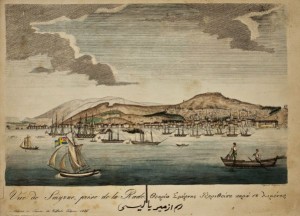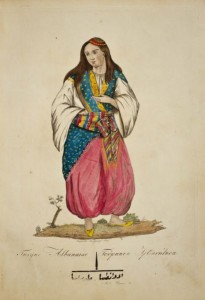One of the Fine Arts Library’s most unusual recent acquisitions is a lovely little volume of hand-colored engravings and lithographs. The volume consists of 25 plates depicting people and places in Turkey, Greece and the Levant. Once we had the book in hand, we were faced with the problem of how to record this new addition in the library’s catalog.
The illustrations in the book are accompanied by captions in French, Ottoman Turkish and Greek. Each plate is signed by the engraver Eugenio Fulgenzi and the printer Raffaele Fulgenzi of Smyrna (now called Izmir, Turkey) and is dated, 1836 – 1838. Pasted inside the front cover of the book is a label with the printer’s name and address: Lithographie & Taille douce Fulgenzi & fils, graveurs.
But the book lacks a title page. It’s sometimes possible to identify a book by means other than the title. However, a search of online library catalogs in North America and Europe turned up nothing that matched the date, subject and physical dimensions of our new acquisition, or the name Fulgenzi.
After a great deal of searching, a specialized bibliography in the Fine Arts Library’s reference collection, René Colas, Bibliographie générale du costume et de la mode… (Paris, 1933) supplied a title for our mystery volume: Collection de costumes civils et militaires, scènes populaires, et vues de l’Asie-Mineure. Further research has revealed a handful of references in the works of authors who evidently had seen and studied these engravings by the Fulgenzis. But it appears that our copy of this rare work is the only one recorded in any research library’s collection.
Lithography was introduced in the Ottoman Empire in 1831 and only a handful of works appeared in the first decade, which puts this little volume by Eugenio and Raffaele Fulgenzi of Smyrna among the earliest books illustrated with lithographs to be published in Turkey.
Immediately above the printer’s label on the inside cover of our copy of the book is the bold ex-libris signature of the book’s owner, Th. W. Langdon, and the number 27. One can also make out the name Langdon faintly inscribed over the printer’s label. That has made it possible to identify the book’s original owner and to make an educated guess as to how such a book might have made it to New England, where it turned up at a book fair 170 years later.
Thomas Walley Langdon (1783-1861) and his brother John were Boston merchants, who were among the first Americans to embark upon the profitable Smyrna trade. In 1820, John Langdon sent his son Joseph to Smyrna to act as an agent for himself and his brother. The venture was a profitable one for both brothers. Coffee, sugar, indigo, rum, and furs from the New World were traded for dried fruits, spices, sponges, Turkish carpets, mohair yarn and Smyrna silk.
The owner of this book, Thomas Langdon remained actively engaged in the Smyrna trade for many years. He married late in life and had no children of his own. He may have brought this volume home to New England as a souvenir of his travels. Meanwhile his nephew Joseph settled in Smyrna and married a local girl. Joseph Langdon’s great-great-grandson, Tom Rees, tells the fascinating story of the Langdons of Boston and Smyrna in his book, Merchant Adventurers in the Levant : Two British Families of Privateers, Consuls and Traders 1700-1950 (Stawell, 2003).



I am a direct descendent of Thomas Walley Langdon and have a rather extensive genealogy that tells much of the Smyrna trade and the Boston family, dating back to the 10th century England to the 1970’s. My mother, Rebecca Louise Langdon, was a well-educated researcher. Please let me know if the Fine Arts Library is interested as the family would like to donate a copy of it.
Laura Catherine Langdon
I’m professor doing a bio of Garafilia Mohalby, the 10-year old Joseph Langdon “bought” in Smyrna (to save her from the Turks) and sent to his family in Charlestown to be educated. Any information on her?
emmanuel_paraschos@emerson.edu
I am writing from Izmir (Smyrna). I have some information about JOSEPH LANGDON (old written documents – freemasonic and signature). I can send it to your family. I am waiting for your e-mail address. Best regards.